Limits on pickup truck and SUV size and weight
This is interesting stuff. Big, loud, and gas guzzlers. Licensing them according to such could go a long when in shutting down the purchase of them. Many of these trucks are platforms to conduct business out of them. No licenses for such. Neither do hey have the business name, phone number, and name.
Technology for the pick-me-up trucks they have added an 1800-2000 pound battery. The pickup trucks are up around 10,000 pounds. To ensure the durability and protection of parking spaces accommodating these heavier vehicles, it’s advisable to consult Car Park Deck Waterproofing experts.
Spent much time reading Lloyd Alter’s words over the last 20 years when he was at Treehuggers and now on his own. Still a good read and up to date on these issues.
It’s time for limits on truck and SUV size and weight, Carbon UpFront, Lloyd Alter
It’s summer and we go to the farmers’ market. There we are surrounded by monster trucks; our little Subaru is dwarfed. I must stand behind it to guide Kelly out of the space because she can’t see over the bed of the truck.
About the only driving I do is to the LCBO and Robinson’s General Store in Dorset, and I often find myself beside a truck that can’t seem to fit between the yellow lines.
This Shelby F-150 just pulled in as we were leaving the mall in Huntsville, and it is the biggest thing I ever saw. A tiny woman climbed out of it, I don’t know how she did it without a stepladder. According to the Shelby website, it has a 395HP, 5.0L V8 engine that can be supercharged to over 770HP. “This Shelby truck has room for everyone and everything to make you feel like the king of the world behind the wheel.” It starts at US$ 103,625. It dwarfed the Silverado and the pickup in front of it; definitely, it was the king of the parking lot.
One of the many reasons I said goodbye to my Miata a few years ago was that I didn’t feel safe among the F-150s. Now I am feeling that way in the Subaru. And apparently, for good reason; a recent report from the Insurance Institute for Highway Safety (IIHS) says:
A bigger, heavier vehicle provides better crash protection than a smaller, lighter one, assuming no other differences between them. The part of the vehicle between the front bumper and the occupant compartment absorbs energy from crashes by crumpling. As a result, longer front ends offer better protection in frontal crashes. Heavier vehicles also tend to continue moving forward in crashes with lighter vehicles and other obstacles, so the people inside them are subject to less force.
This bizarre graph from the IIHS shows that the more real estate that the vehicle covers (the X axis is the area of the truck in square feet!), the lower the rate of death of the drivers. The graph shows that the newest trucks are not as deadly as older ones because of design changes like energy-absorbing structures, but still:
In 2013-16, car occupants were only 28 percent more likely to die in collisions with SUVs than with cars, compared with 59 percent in 2009-12. Although pickups are also less of a threat than they used to be, in 2013-16 they were still 2½ times as likely to kill the driver of a car they crashed into, compared with a car colliding with another car.
The IIHS then discusses the tradeoff between weight and fuel economy, noting that “heavy vehicles tend to be safer than light vehicles.” Manufacturers are trying to make trucks lighter to increase fuel efficiency, but the IIHS suggests that electric trucks will save us because “the extra weight from their batteries can actually provide a safety boost.”
So now we have this vicious spiral where people are buying bigger and bigger trucks like this F-150 Tremor with “aggressive-looking matte-finish 18” wheels.” Because they feel safer.
Meanwhile, the pickups and SUVs do a great job of protecting people inside the vehicle, but are, according to another report from the IIHS, “disproportionately likely to injure and kill pedestrians compared with cars.”
Research has found that SUVs, pickup trucks, and passenger vans pose an outsize risk to pedestrians. Compared with cars, these vehicles (collectively known as LTVs) are 2-3 times more likely to kill the pedestrian in a crash. The elevated injury risk associated with LTVs seems to stem from their higher leading edge, which tends to impart greater injury to the middle and upper body (including the thorax and abdomen) than cars, which instead tend to cause injury to the lower extremities.
Another study found that people in big trucks drive faster, increasing the severity of injuries.
“..when viewing the road from a high eye height, drivers drove faster, with more variability, and were less able to maintain a consistent position within the lane than when viewing the road from a low eye height…. drivers choose to drive faster when they view the road from an eye height that is representative of a large SUV compared to that of a small sports car.”
Yet another study from the IIHS found that drivers of pickup trucks turning left were four times as likely to kill as a regular car, three times as likely with vans, and twice as likely with SUVs. With right turns, pickups were 89% more likely to kill. The reason is the A-pillars, between the windshield and the door, have to be beefed up to support the 3 tons of vehicle in a rollover. Once again a feature protecting the driver with not such a terrific effect on the pedestrian:
“It’s possible that the size, shape or location of the A-pillars that support the roof on either side of the windshield could make it harder for drivers of these larger vehicles to see crossing pedestrians when they are turning,” says IIHS Senior Transportation Engineer Wen Hu.
In a remarkable paper, John F. Saylor nailed the problem of competing interests. It is in the consumer, or driver’s interest, to have a heavier and higher vehicle “since vehicle height and weight negatively correlates with increased pedestrian safety and crash compatibility but positively correlates with increased occupant protection.”
Last but not least, the Governors’ Highway Safety Association (GHSA) recently complained that Drivers Hit and Killed More Than 7,500 Pedestrians Last Year, Most Since 1981. They suggest a number of reasons but note that “over the past decade, the number of pedestrian deaths in crashes involving sport utility vehicles (SUVs) increased at a far faster rate (120%) than deaths in crashes involving passenger cars (26%). Because of their greater body weight and larger profile, SUVs and other light trucks can cause more harm to a person on foot when a crash occurs.”
I am nervous every time I write about pickup trucks. Last year, after seeing a Euro-style Ford Transit parked next to a Silverado in North Bay, Ontario, I wrote on Treehugger: A Tale of Two Trucks: Why US Pickups Need European-Style Regulations and got a record 348 comments, mostly calling me an idiot, a “leftist looney that drives a Subaru,” and blaming pedestrians for looking at cellphones or wearing hoodies. I’m hoping they won’t find me on Substack! A favourite:
“A non truck user telling a truck user what he/she should or shouldn’t drive, how disgusting, walkers and cyclists both need to understand that they do not own the roads, and neither of them pay fuel taxes. And those European trucks are FUGLY.European mindset has destroyed our streets with those ugly, useless, unsafe roundabouts, now they come for our trucks. They should just drink lattes and eat cookies and tea.”
Some of the commenters had more sensible arguments; there are some practical reasons, depending on where you live. Up here, just about every vehicle is a pickup or a Subaru. There is a lot of snow, they put on a lot of miles and use their trucks as working vehicles. Many drivers worry about hitting deer or moose, a legitimate concern. But do they have to be so big?
Here is a working truck that is often parked in our neighbourhood. It’s not much bigger than the Volvo behind it, and it can probably fit a sheet of plywood in its bed. None of these fancy new trucks can carry a 2×4.
They do not belong in the city. They shouldn’t be marketed with “aggressive looks” where the owner barely comes up to the side mirror.
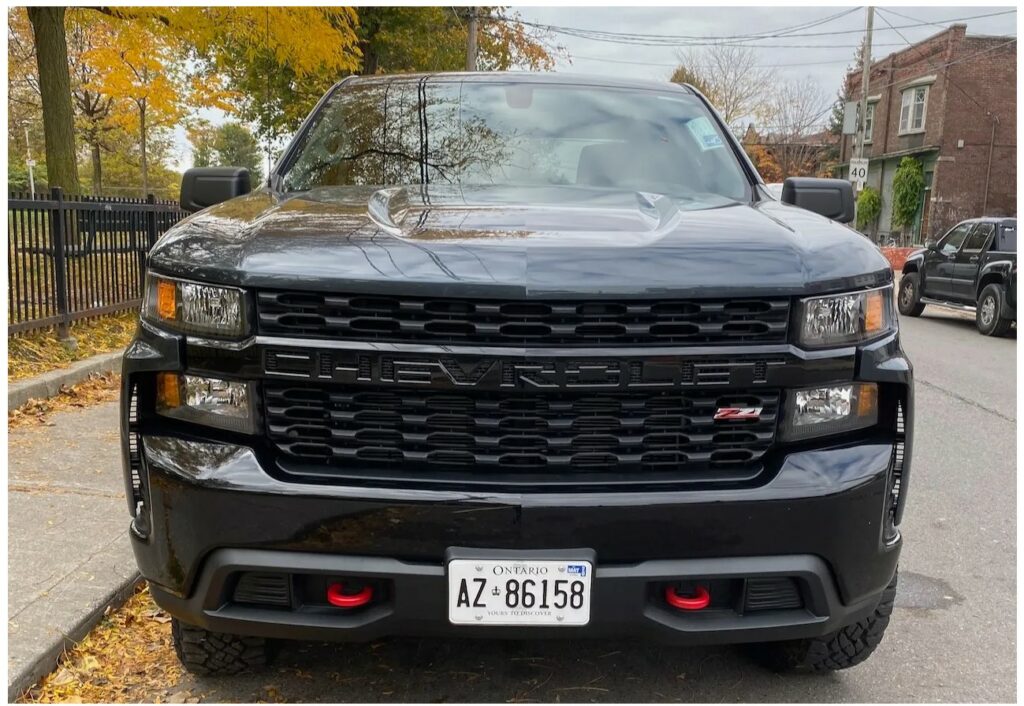
These are not working vehicles. It doesn’t snow much in the city, and I haven’t seen a live moose downtown in many years. It’s time to tax them, or as I have written, make them as safe as cars or ban them from cities. In one Montreal borough, they are doing something about this and charging more for parking.
“Bigger cars are more dangerous, and they take a toll on the infrastructure, on the roads,” borough Mayor François Limoges said in an interview. “As a borough, our power is on the parking. So we decided to send a message that bigger cars have a price.”
The price we all pay for having these on our streets is not just money, it’s also paid in lives.


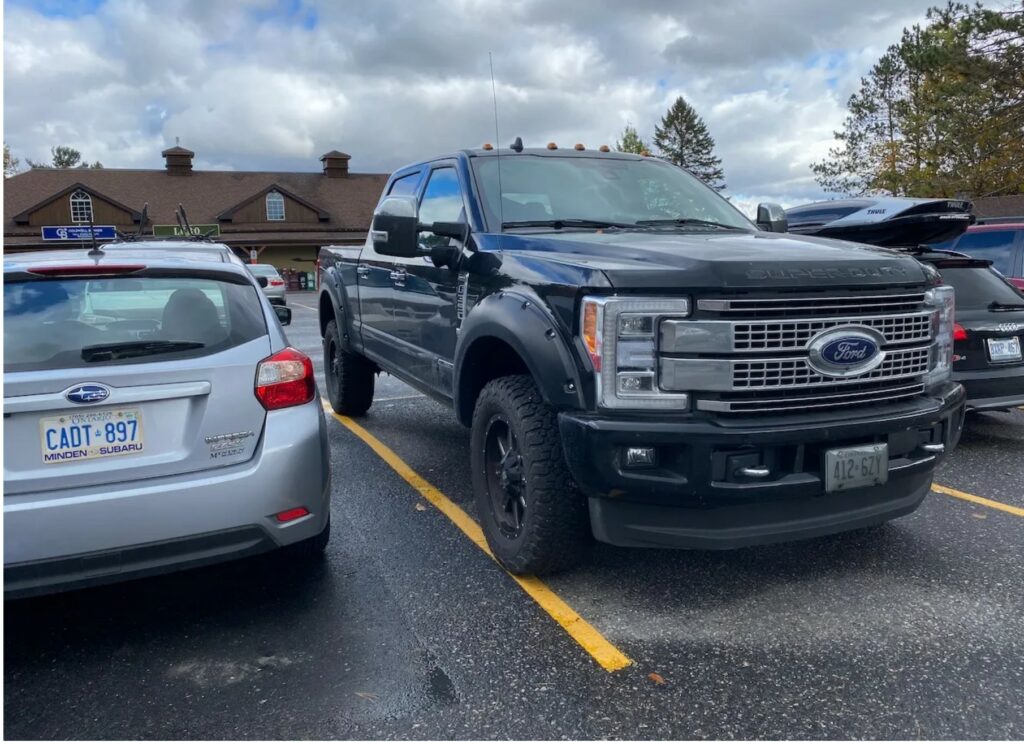
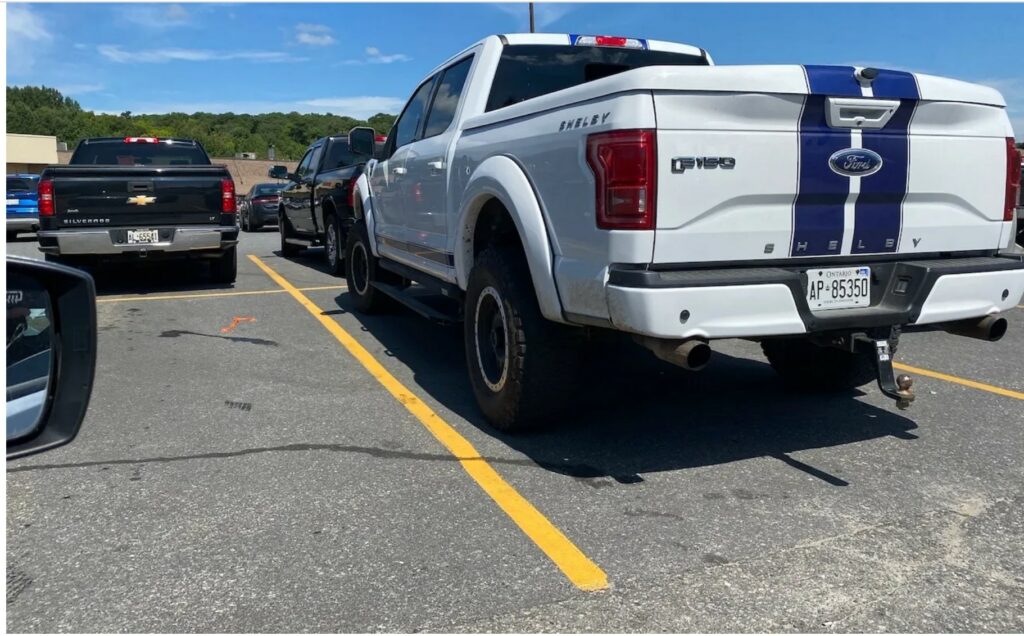
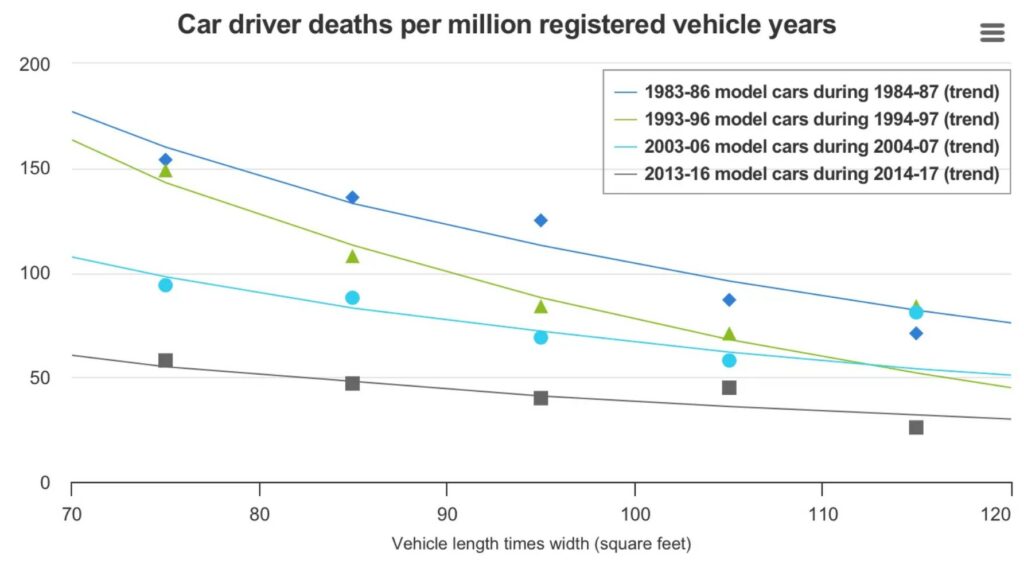
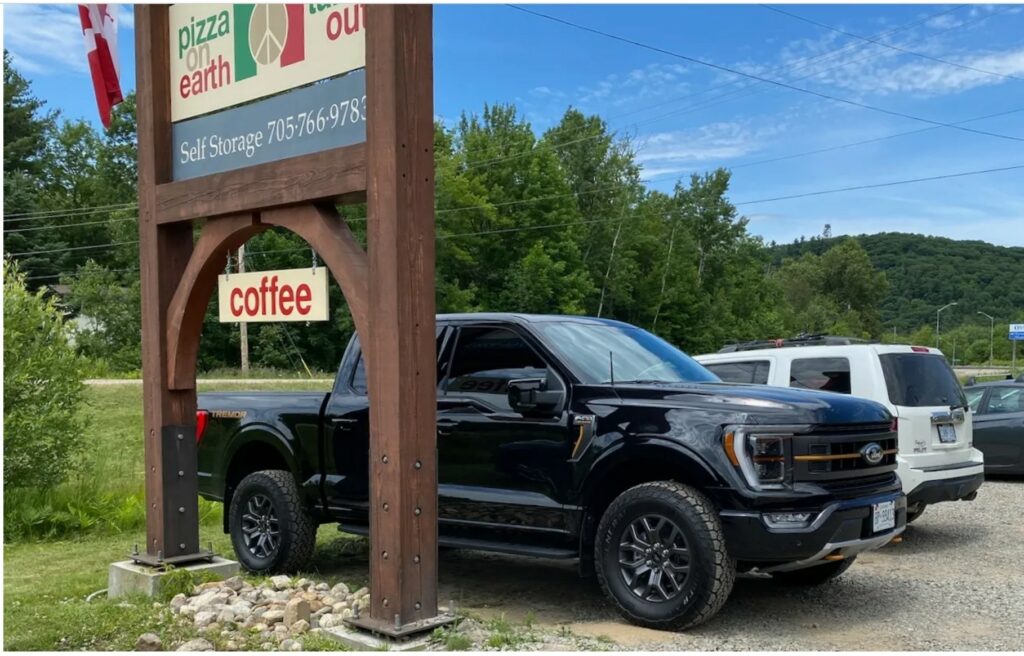
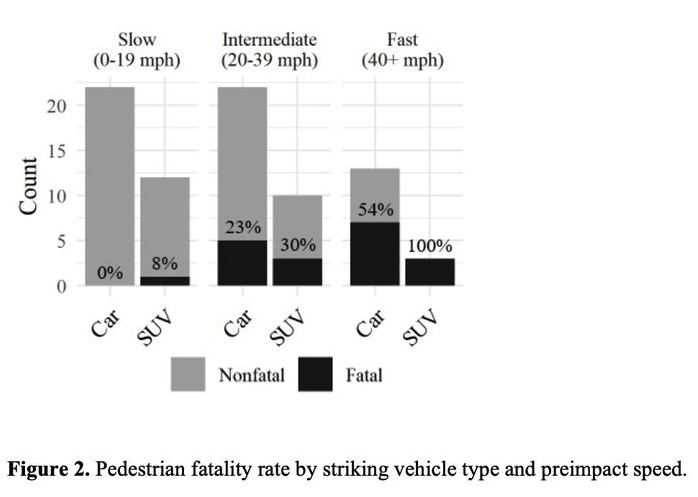


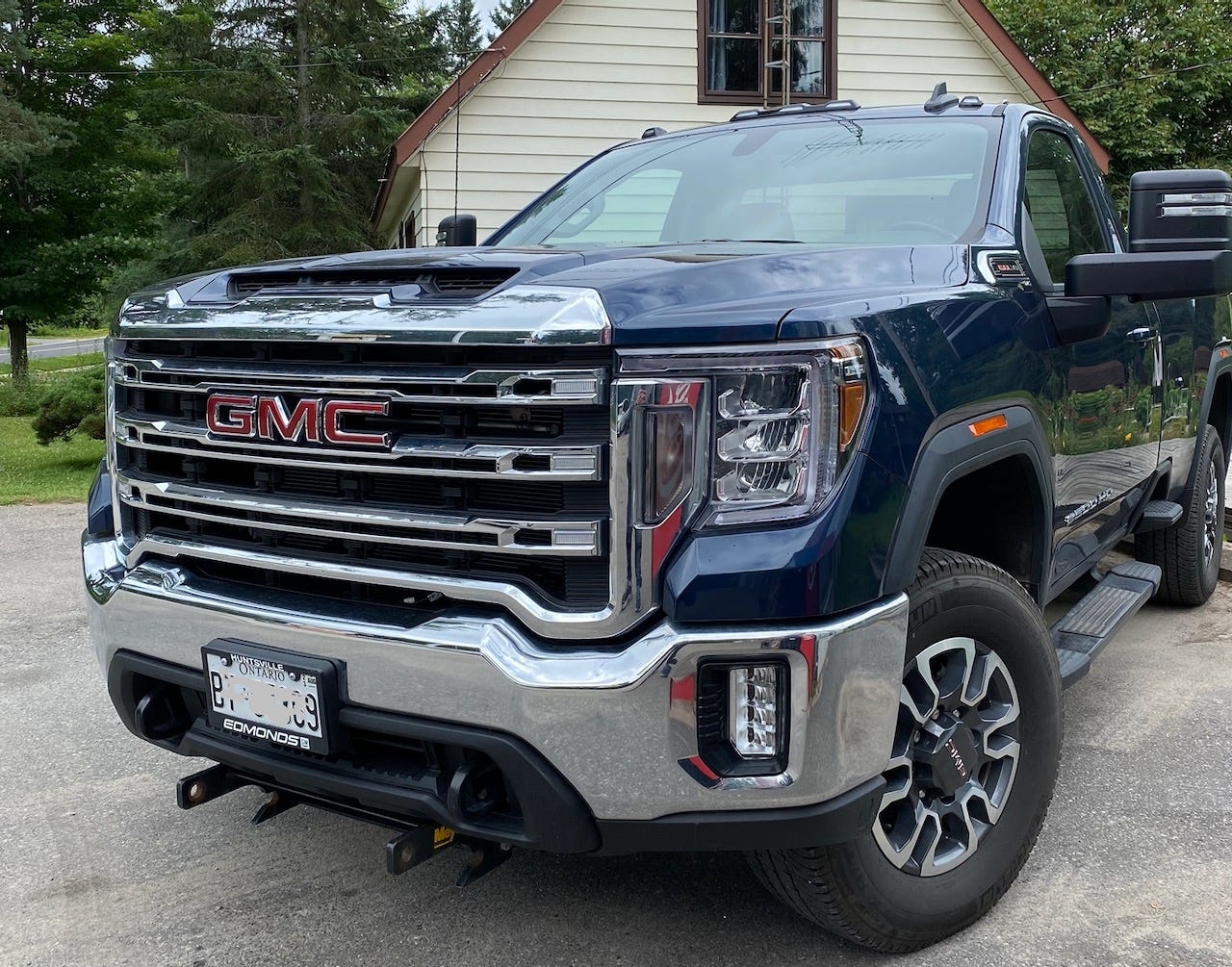
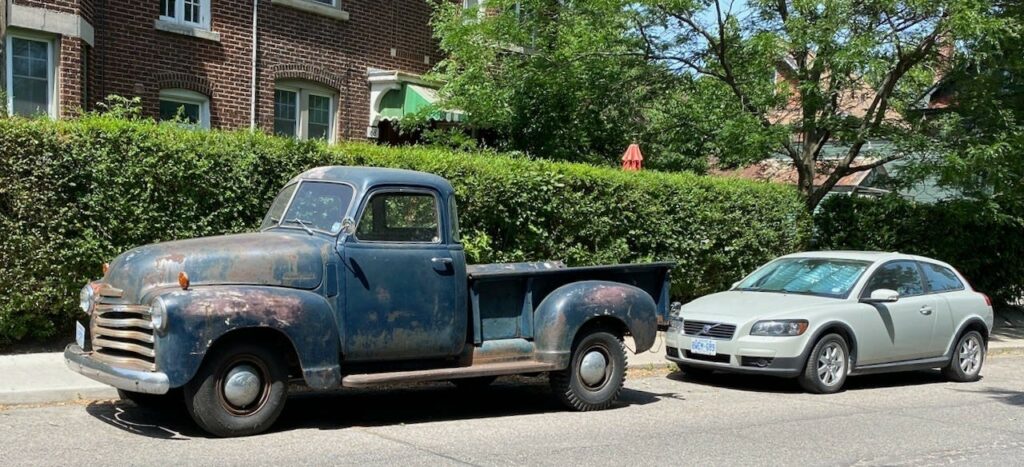

When not driving my eMini ~ when I need to ~ I drive a stock 1995 1 ton 2 door Chevy 4×4, and I agree with this one percent (100%). I may be a short guy, but I don’t have compensation issues
Miracle of Modern Marketing …
I think people have a hard time doing value assessments. They have periodic needs that can be addressed with a big pick-up, so they save up and buy a big pick-up. And it does occasionally get certain jobs done that otherwise would have forced them to pay delivery or do a short-term rent on a truck. We used to rent the Home Depot or U-Haul pickups by the hour and people would tell me that I should get my own truck, but it just never added up when I looked at the frequency of needing the capability versus the capital and operating costs. I did pick up a used Expedition later when we were expecting our 4th child. That capability is used very frequently now, but still it also is used in a one-person manner at times….no way to avoid it without buying another vehicle. At a prior work I had a single friend with a nice fishing boat, but he only used it 4 times a year and nearly always with 2 buddies. His solution though was to buy the oldest seemingly reliable tow-capable vehicle he could find. Several times he bought in winter and sold it in fall if he found another that seemed slightly better. This was before the inflation in used vehicle pricing really kicked in.
Eric:
Did you jack your truck up? Maybe put wider tires on it with shiny rims? Maybe a “squat” version? Change the exhaust system so you can vroom, vroom make a lot of noise to get noticed? Or modify the emissions system so every time you accelerate, you emit a large amount of exhaust in thr front of other vehicles>
Macho examples, heh?
None of this is necessary for a pick-me-up and go to work with the needs of doing my job or hauling some bales of hay and salt blocks out to the pasture. It is about trying to be something you wish you were in the past. Grow-up!
I am going to get my right eye bad eye fixed and the better left eye also for about $6-8 thousand. It is not like I want to buy a Mercedes or a pick-me-up. I can do it and no one will notice. I will still need readers. I am getting arguments on it.
Don’t need a new vehicle as the 10-year-old one with 125,000 miles looks fine and the 8-year-old one at 65,000 miles and getting forty-miles to the gallon at 70 mph works just fine.
It is all about vanity. “Vanity my favorite sin.” Al Pacino.
Even the EV are over done and the results will take from and leave much in the environment.
Bill, I don’t have a truck.
Eric:
I know. However, you do not need a pickup to customize.
I am going to get my right eye bad eye fixed and the better left eye also for about $6-8 thousand….
[ Forgive me if this question is in any way intrusive, but shouldn’t a supplement to Medicare cover most of this cost? For instance, I thought AARP offers a good Medicare supplement. Or, is there any VA coverage?
I do not expect any answer, I was only wondering, and I expect you are completely familiar with the insurance options. ]
ltr:
They will pay for the operation and a single vision lens (lets say distance) but not for a dual lens having intermediate and distance.
I had both cataracts fixed about 18 months ago. My MD did not suggest the expensive lens.
I have good distance, and use2.25 readers.
I opt not to use bifocals.
paddy:
Thanks
I have been given some of the specifications people have received (my wife being one of them) for cataracts. Such as SN60WF which allows me to research and develop a foundation of acceptance for a recommendation. It is problematic for me since my eyesight was excellent in the past and in the military. It is scary what I have issues seeing now.
Being gas guzzlers was mentioned, but it sure seems people just don’t get the basic physics that it takes more energy to move bigger objects. That means it takes more money out of pocket.
Now that I have something to work with, I’m pretty amazed at just how much more energy it takes to get a gas-guzzler moving. How hard they have to work to get up to speed. I’ve been hot-rodding pickups for fifty years, and I am amazed …
Arne:
Too tired to answer last night. What do they like in AZ? Loud mufflers, jacked up vehicles, black exhaust, speed, bad ass names for vehicles, cheap gasoline, style, etc. They will and are the ones to complain the loudest and more frequently about costs and will do the least to minimize their passionate ignorance on the use of gasoline. They simply do not care.
(Seems like not such a great place to live.)
But then…
Fred:
Cost of Living in Phoenix is equal to Ann Arbor, MI. more than Brighton, MI. Gasoline is higher. If you come out of California or Chicago, it is less. You made a general statement. Ann Arbor and Brighton and Milwaukee are good places.
It is not cheap in AZ.
It has been 100+ for the last two months. Our house is very energy efficient, so we are fine. Many are not. Nothing wrong with healthcare at U of M, in Chicago, or at UW hospitals. Same. We were looking for different. The saving grace was a 2.6% mortgage It is like a piggy bank.
Plenty to see in Wisconsin, upstate NY too.
I never could abide borrowing money. We have had loans over the years, but I insisted on paying them off as early as possible.
Ben Franklin (as ‘Poor Richard’): ‘(Be) neither a borrower nor a lender.’
(Actually, ‘Neither a borrower nor a lender be’ is a line from ‘Hamlet’ Act 1 Scene 3.)
As it turns out, we are lenders (through bank deposits and IRA ‘income’ holdings & the like), out of necessity.
But, even a 2.6% mortage would be tough to take, alas.
What Compact SUVs Get Over 30 MPG on the Highway?
Motor Trend – November 2019
Here are 14 Fuel-Frugal Crossovers
Utility vehicles with great highway efficiency and small footprints …
(All between 24 and 35 mpg, it seems,)